That's what researchers from Athens aimed to discover by comparing the physiological and agronomic response of Assyrtiko grapevines to the island’s traditional training system, Kouloura, and the globally used VSP (vertical shoot positioned) system, over two growing seasons (2019–2020 and 2020–2021) at Domaine Sigalas (below), near Oia.
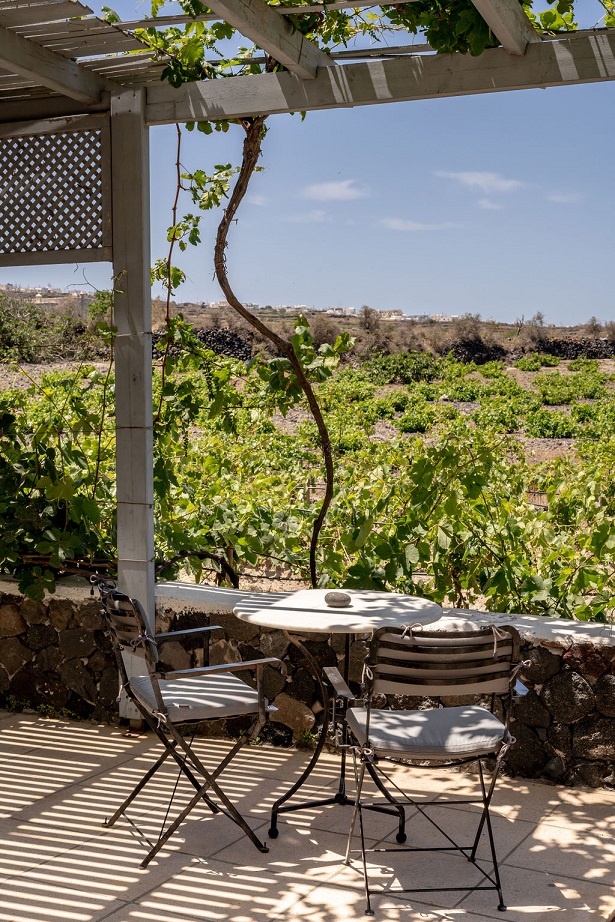
They found the wreath-like Kouloura system, which has been used for thousands of years on the island, maintained a less-stressed water status compared to VSP. It also exhibited significantly higher photosynthetic rates and stomatal conductance.
Regarding microclimate observations, the researchers found that, especially during heatwaves, VSP’s grapes were more exposed to higher temperatures during midday than Kouloura and that the Kouloura system offered better protection against damage from heatwaves and strong winds.
Changing training systems is a particularly interesting proposal to mitigate the effects of climate change because it can be done without changing the variety grown and, in some cases, without the need to replant and restructure the entire vineyard. It can also be used with other mitigating measures, such as more suitable clones/rootstocks/varieties, and decreasing planting densities.
The vines
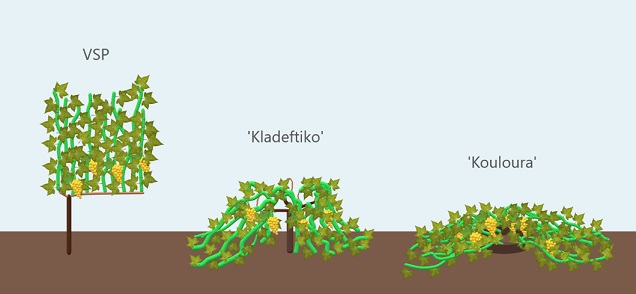
Own-rooted and phylloxera-free vines have been cultivated in the volcanic soil of Santorini for thousands of years. The two traditional training systems on the island, part of Greece’s Cyclades, are the Κouloura (KLR) and the Κladeftiko (above), which are well-adapted to the extreme climatic conditions here. VSP is also used in some vineyards.
The vines used in the research were own-rooted and in adjacent vineyards: one with the Kouloura system, where the vines are cane-pruned to 4-6 canes of 8-10 nodes at 2.3m × 2.3m intervals, resulting in a vine density of 1,900 plants/ha; and one vineyard N-S oriented with vines unilateral cordon-trained (unilateral Guyot) and cane-pruned to 8-10 nodes at 1.9m × 1m intervals (double lines), resulting in a vine density of 5,300 plants/ha.
The dry-farmed plots chosen for sampling are just metres apart, assuring homologous soil characteristics (rocky-sandy texture). They are also the same age – both vineyards were established in 2006.
Results
Canopy structure: The KLR system produced the largest exposed canopy surface area while net mean photosynthesis during veraison on fully exposed leaves was 30% higher. KLR maintained a more beneficial microclimate, especially during heatwaves, with lower leaf, grape and under canopy temperatures during days and time periods with high temperatures than open-air and the VSP training system.Vine water status: There were significant differences in midday vine water status for both years, where KLR appears to be more resistant to water stress than VSP. Differences in water status were also reflected in the morning, which suggested that KLR had more access to soil water, most likely resulting from the lower planting density. These findings are consistent with published literature highlighting bush vines and low-density vineyards as more drought resistant.
Photosynthesis and gas exchange: For both studied years during veraison, KLR exhibited significantly higher photosynthetic rates than VSP. At bunch closure and harvest, there were no significant differences.
Heatwave responses: In general, the researchers found that during the 2021 heatwave, KLR presented lower midday temperatures than VSP. These lower temperatures can potentially protect fruit grown with the KLR system from damage and/or decreased quality. There is an optimum temperature for vine development and grape ripening, and extreme temperature events can cause damage to leaves and grapes. High temperatures (>35°C) could reduce phenolic content and alter photosynthesis. Temperature also affects grape berry composition, particularly the type and concentration of aromatic compounds. To be specific, the VSP training system exhibited lower values (~25°C) than KLR and open-air temperature at night. During the morning, no differences were observed between the training systems and open-air temperatures. From 11am to 3pm, when temperatures were at their maximum, the open-air temperature reached values around 42°C. For the same period, VSP and KLR showed markedly lower values (~38.5°C and 37°C, respectively) than open-air temperature, while the KLR presented the lowest values. From 4pm to midnight, no differences were observed.
The findings for the 2021 harvest were similar. At midday, during harvest, the sun-exposed side of VSP grapes showed significantly higher temperatures than KLR. The shaded grapes were not significantly different.
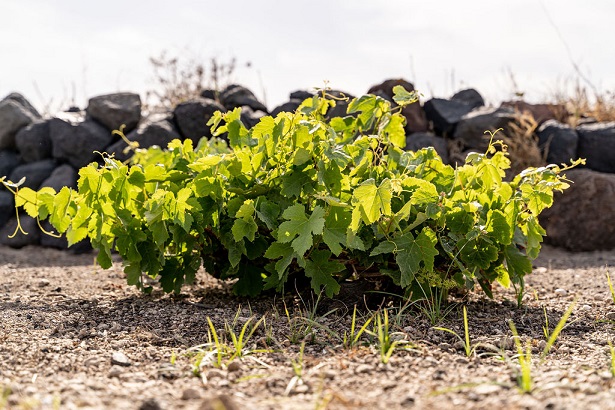
Regarding humidity, in 2021, during the morning, KLR had significantly higher humidity (~66%) than open-air and VSP, and VSP presented the lowest values (~55%). At midday, KLR showed markedly higher humidity (~56%) than VSP (46%). At night, there were no significant differences in humidity between the training systems.
In 2020, during the morning, temperatures for both training systems were significantly lower (~28°C) in comparison to open-air (~31°C). At midday, temperatures for both training systems were also significantly lower (~33°C) than open-air temperatures (~38°C). At night, KLR and VSP had significantly higher values (~26°C) than open-air.
But the most significant finding, for me, was that, during the heatwave, there were clear differences in fruit damage levels between the two training systems: KLR exhibited 19% damaged fruit while VSP reached 32%. This led the researchers to write: “After recording damages from summer heatwave and early spring winds, we found that KLR is better adapted to the climate condition of Santorini than VSP by protecting the grapes from the consequences of the extreme conditions of the island.”
Yield components and grape composition: There were no significant differences between the two training systems for most of the analysed attributes except for bunch length, where VSP was significantly longer than KLR for both studied years. Average yields were quite similar between KLR and VSP. In 2021, when there was lower precipitation and higher temperatures, the yield of KLR was higher than VSP. But KLR produced a lower yield in the bumper 2020 vintage – which came after high rainfall rates the previous year. Concerning the grape composition, the only significant differences were for 2021, where VSP showed markedly higher acidity and lower sugar content than KLR.
Conclusion
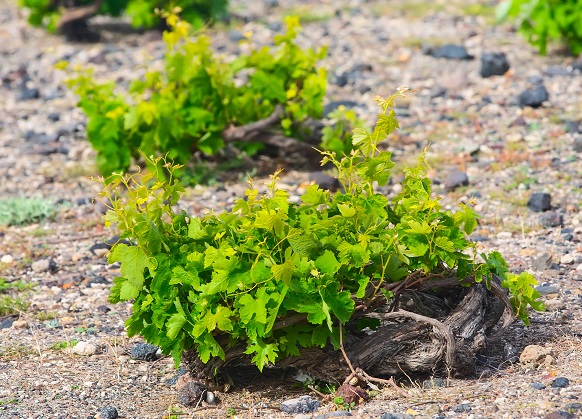
The traditional Kouloura training system used in Santorini is well-adapted to the extreme climatic conditions of the island. That's why it has persisted through time and become part of the authenticity of the landscape and part of the terroir of this semi-arid wine region.
The key takeaway from this study by Efstratios Guillaume Xyrafis, Gregory A Gambetta, and Katerina Biniari is that viticulturists who are looking for ways to adapt their training system to the new climatic conditions should look at all the traditional training systems used in the Mediterranean basin. These systems – which include Kouloura, the Mediterranean goblet and bush vine – have proved resistant to drought and high temperatures over centuries.
To view the original paper in OENO One (Vol. 57 No. 3, 2023), click here.


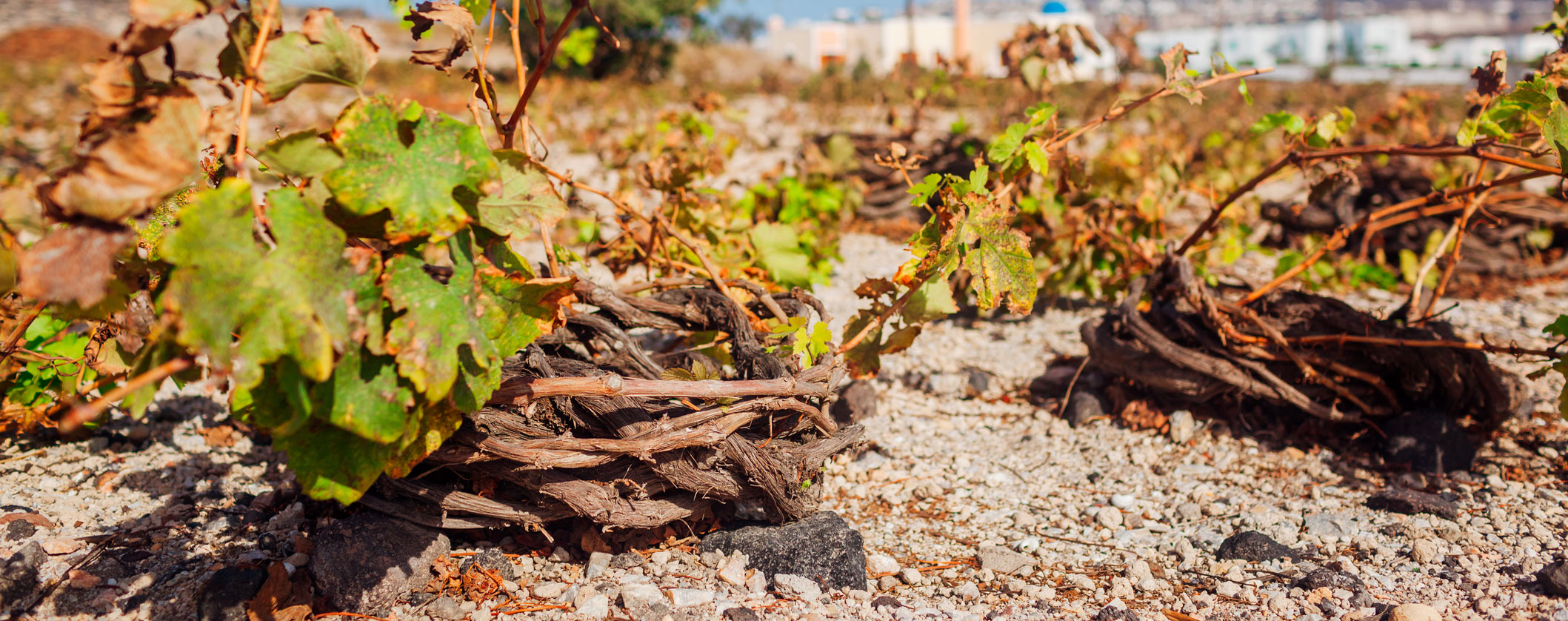










.png)






